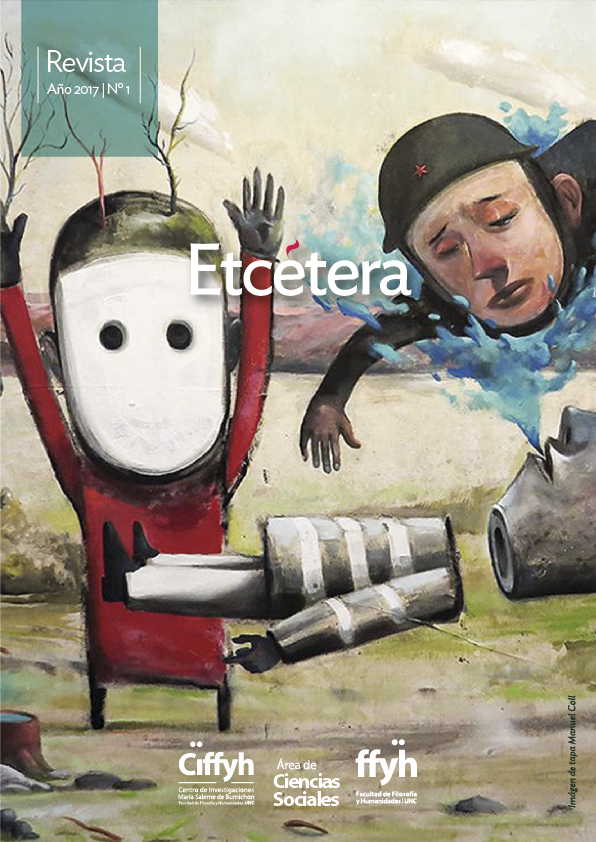Introduciendo Escenas Musicales
Keywords:
music scenes, music industry, communicationAbstract
Translation of Bennett, A. y Peterson, R. A. (Eds.): "Introducing Music Scenes". Music Scenes. Local, Translocal and Virtual. Nashville: Vanderbilt University Press.Downloads
References
Becker, H. (1951). “The professional dance musician and his audience”. En: American Journal of Sociology, Nº 57, pp. 136.44. Estados Unidos: University of Chicago Press.
Becker, H. (1963). Outsiders: studies in the sociology of deviance. New York: Collier Macmillan.
Becker, H. (1976). “Art worlds and social types”. En: Peterson, R. (ed.), The production of culture. Beverly Hills: SAGE Journals.
Becker, H. (1982). Art worlds. Berkeley: University of California Press.
Bennett, A. (1999). “Subcultures or neo-tribes? Rethinking the relationship between youth, style, and musical taste”. En: Sociology, Nº 333, pp. 599-617. Inglaterra: British Sociological Association.
Bennett, A. (2000). Popular music and youth culture: music, identity, and place. Londres: Macmillan.
Bjurström, E. (1997). “The struggle for ethnicity: Swedish youth styles and the construction of ethnic identities”. En: Young: Nordic Journal of Youth Research, Nº 5, pp. 44-58.
Bourdieu, P. (1984). Distinction: a social critique of the judgement of taste. Londres: Routledge and Kegan Paul.
Chaney, D. (1996). Lifestyles. Londres: Routledge.
Clarke, G. (1990). “Defending ski-Jumpers: a critique of theories of youth subcultures”. En: Firth, S., y Goodwin, A. (eds.), On record: rock, pop, and the written word. Londres: Routledge.
Cohen, S. (1991). Rock culture in Liverpool: popular music in the making. Oxford: Clarendon Press.
Condry, I. (1999). “The social production of difference: imitation and authenticity in Japanese rap music”. En: Fehrenbach, H., y Poiger, U. (eds.), Transactions, transgressions, transformations: American culture in Western Europe and Japan. Providence: Berghan Books.
Denisoff, S., Peterson, R. (eds.). (1972). The sounds of social change. Chicago: Rand-McNally.
DeVeaux, S. (1997). The birth of BeBop: a social and musical history. Berkeley: University of California Press.
Duncombe, S. (1997). Notes from underground: zines and the politics of alternative culture. London: Verso.
Forman, M. (2002). The hood comes first: race, space, and place in rap and hip-hop. Hanover: Wesleyan University Press.
Frith, S. (1983). Sound effects: youth, leisure, and the politics of rock. Londres: Constable.
Frith, S. (1996). Performing rites: on the value of popular music. Cambridge: Harvard University Press.
Gaines, D. (1994). “The local economy of suburban scenes”. En: Epstein, J. (ed.), Adolescents and their music: if it’s too loud, you’re too old. New York: Garland.
Gebesmair, A., y Smudits, A. (eds.). (2001). Global repertories: popular music within and beyond the transnational music industry. Aldershot: Ashgate.
Gelder, K., y Thornton, S. (eds.). (1997). The subcultures reader. Londres: Routledge.
Gilroy, P. (1993). The Black Atlantic: modernity and double consciousness. Londres: Verso.
Harris, K. (2000). “‘Roots?’ The relationship between the global and the local within the extreme metal scene”. En: Popular Music, Nº 191, pp. 13-30. Cambridge University Press.
Hemment, D. (1998). “Dangerous dancing and disco riots: the Northern Warehouse Parties”. En: McKay, G. (ed.), DIY culture: party and protest in Nineties Britain. Londres: Verso.
Jarviluoma, H. (2000). “From Manchuria to the traditional village: on the construction of place via Pelimanni Music”. En: Popular Music, Nº 191, pp. 101-124. Cambridge University Press.
Kibby, M. (2000). “Home on the page: a virtual place of music community”. En: Popular Music, Nº 191, pp. 91-100. Cambridge University Press.
Kruse, H. (1993). “Subcultural identity in alternative music culture”. En: Popular Music, Nº 121, pp. 31-43. Cambridge University Press.
Laing, D. (1985). One chord wonders: power and meaning in punk rock. U.K: Open University Press.
Laing, D. (1997). “Rock anxieties and new music networks”. En: McRobbie, A. (ed.), Back to reality: social experience and cultural studies. U.K: Manchester University Press.
Lee, S. (1995). “Re-examining the concept of the ‘independent’ record company: the case of Wax Trax! Records”. En: Popular Music, Nº 141, pp. 13-32. Cambridge University Press.
Lena, J. (2003). From ‘flash’ to ‘cash’: producing rap authenticity, 1979 to 1995. Disertación doctoral. Columbia University.
Lipsitz, G. (1994). Dangerous crossroads: popular music, postmodernism, and the poetics of place. Londres: Verso.
McRobbie, A., y Garber, J. (1976). “Girls and subcultures: an exploration”. En: Hall, S., y Jefferson, T. (eds.), Resistance through rituals: youth subcultures in Post-War Britain. Londres: Hutchinson.
Mitchell, T. (1996). Popular music and local identity: rock, pop, and rap in Europe and Oceania. Londres: Leicester University Press.
Negus, K. (1992). Producing pop: culture and conflict in the popular music industry. Londres: Edward Arnold.
Negus, K. (1999). Music genres and corporate cultures. Londres: Routledge.
Olson, T. (1999). “Hippie hootenanny: Gram Parsons and the Not-Quite-Nashville Cats”. En: Journal of Country Music, Nº 203, pp. 26-36. Nashville: The Country Music Foundation.
Peterson, R. (1973). “The unnatural history of rock festivals: an instance of media facilitation”. En: Popular Music and Society, Nº 2, pp. 1-26. UK: Taylor & Francis.
Peterson, R. (1978). “Disco! Its distinctive sound isn’t just another fad”. En: Chronicle of Higher Education, Nº 2, pp. 26-27. Washington.
Peterson, R. (1990). “Why 1955? Explaining the advent of rock music”. En: Popular Music, Nº 9, pp. 97-116. Cambridge University Press.
Peterson, R. (1994). “Culture studies through the production perspective: progress and prospects”. En: Crane, D. (ed.), The sociology of culture. Oxford: Blackwell.
Peterson, R. (1997). Creating country music: fabricating authenticity. Chicago: University of Chicago Press.
Redhead, S. (ed.). (1993). Rave off: politics and deviance in contemporary youth culture. U.K: Avebury.
Rose, T. (1994). Black noise: rap music and black culture in contemporary America. Hanover: Wesleyan University Press.
Ryan, J., y Peterson, R. (1994). “Occupational and organizational consequences of the digital revolution in music making”. En: Cantor, M., y Zollars, S. (eds.), Creators of culture. Greenwich: JAI Press.
Shank, B. (1994). Dissonant identities: the rock ’n’ roll scene in Austin, Texas. Londres: Wesleyan University Press.
Slobin, M. (1993). Subcultural sounds: micromusics of the West. Londres: Wesleyan University Press.
Smith, R., y Maughan, T. (1997). Youth culture and the making of the post-fordist economy: dance music in contemporary Britain. Londres: Department of Social Policy and Social Science, Royal Holloway, University of London.
Straw, W. (1991). “Systems of articulation, logics of change: communities and scenes in popular music”. En: Cultural Studies, Nº 53, pp. 368-388. UK: Taylor & Francis.
Thornton, S. (1995). Club cultures: music, media, and subcultural capital. Cambridge: Polity Press.
Urry, J. (1990). The tourist gaze: leisure and travel in contemporary societies. Londres: Sage.
Wellman, B., y Gulia, M. (1999). “Virtual communities as communities”. En: Smith, M., y Kollock, P. (eds.), Communities in cyberspace. Londres: Routledge.
Williams, R. (1965). The long revolution. Londres: Pelican.
Downloads
Published
Issue
Section
License
Aquellos autores/as que tengan publicaciones con esta revista, aceptan los términos siguientes:
- Los autores/as conservarán sus derechos de autor y garantizarán a la revista el derecho de primera publicación de su obra, el cuál estará simultáneamente sujeto a la Licencia de reconocimiento de Creative Commons que permite compartir, copiar, distribuir, ejecutar y comunicar públicamente la obra, siempre que: 1) se cite la autoría y la fuente original de su publicación (revista, editorial y URL de la obra); 2) no se use para fines comerciales; 3) En caso que se transforme o genere una obra derivada a partir de esta obra, deberá compartise bajo las mismas condiciones establecidas por esta licencia.
- Los autores/as podrán adoptar otros acuerdos de licencia no exclusiva de distribución de la versión de la obra publicada (p. ej.: depositarla en un archivo telemático institucional o publicarla en un volumen monográfico) siempre que se indique la publicación inicial en esta revista.
- Se permite y recomienda a los autores/as difundir su obra a través de Internet (p. ej.: en archivos telemáticos institucionales o en su página web) luego de la publicacion del articulo, lo cual puede producir intercambios interesantes y aumentar las citas de la obra publicada. (Véase El efecto del acceso abierto).
- El titular del copyright es Etcétera. Revista del Área de Ciencias Sociales del CIFFyH.



















